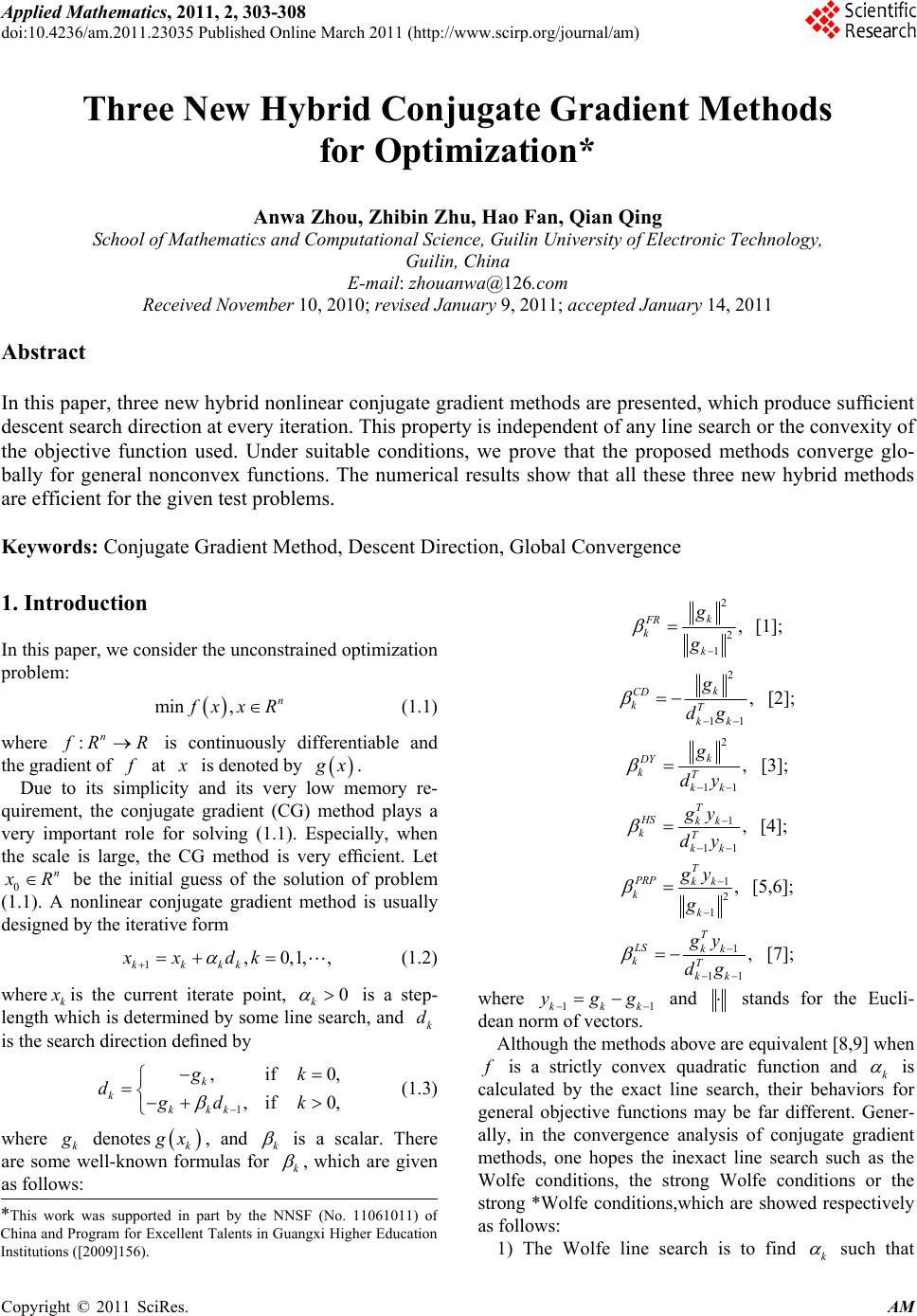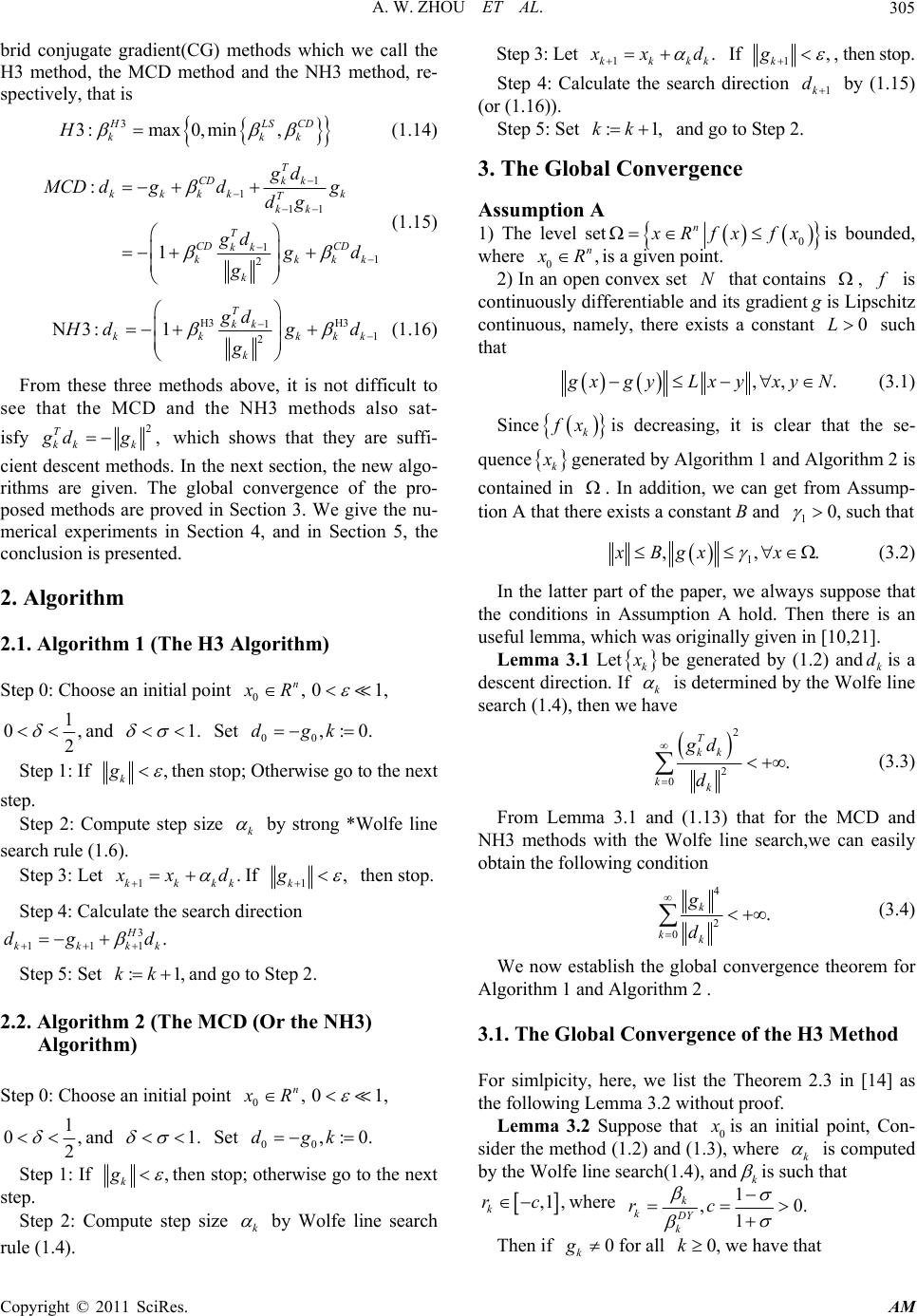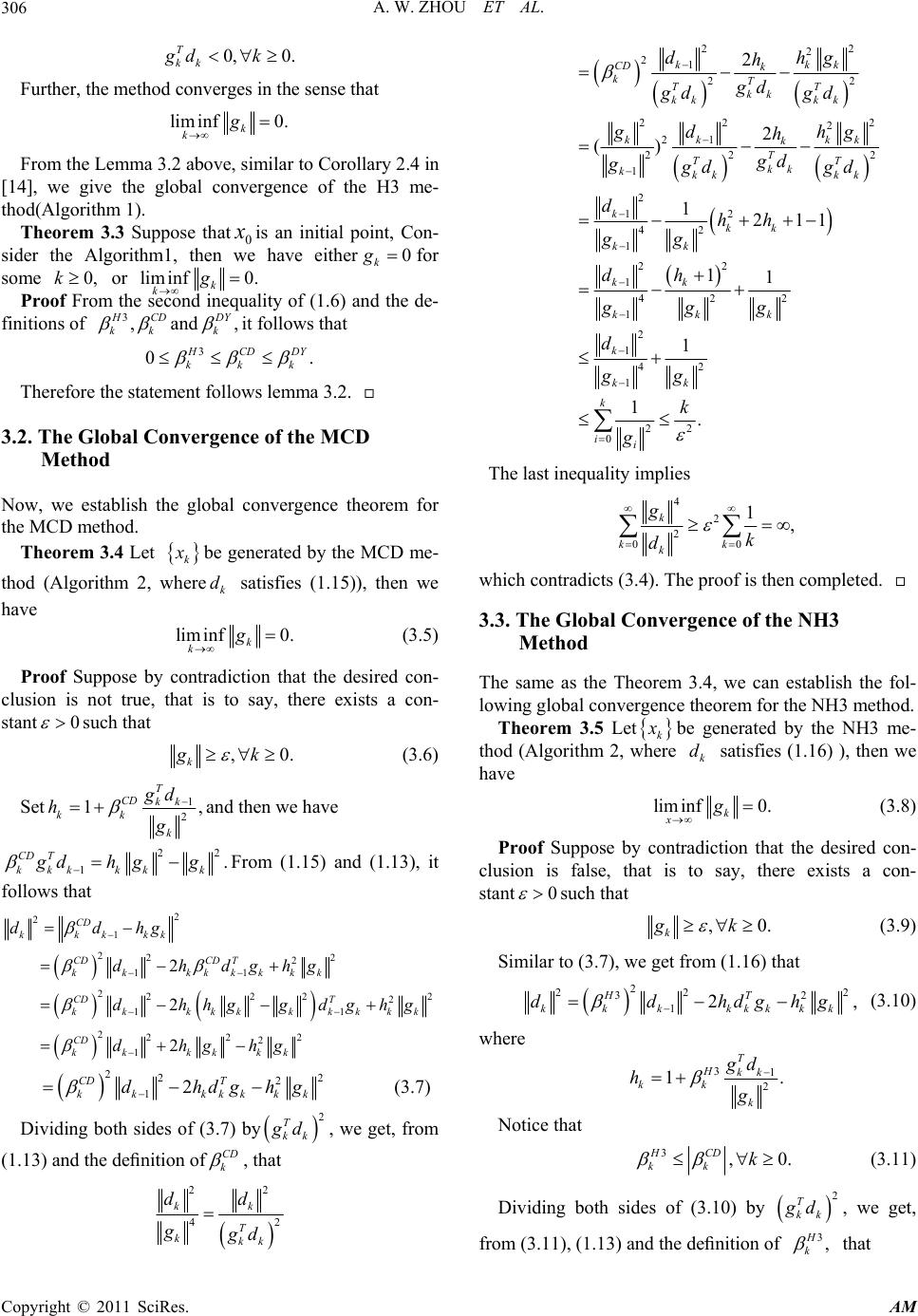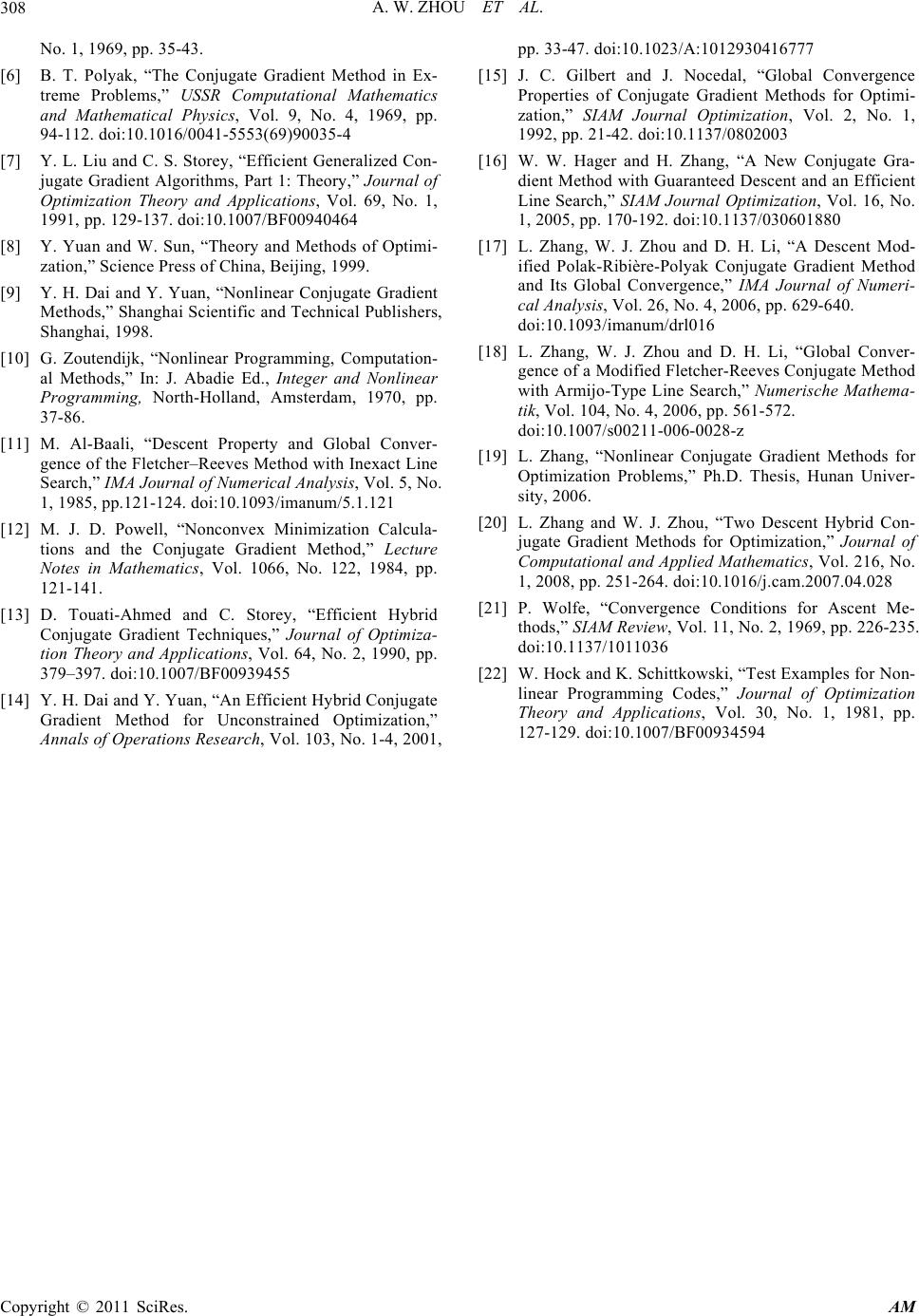Paper Menu >>
Journal Menu >>
 Applied Mathematics, 2011, 2, 303-308 doi:10.4236/am.2011.23035 Published Online March 2011 (http://www.scirp.org/journal/am) Copyright © 2011 SciRes. AM Three New Hybrid Conjugate Gradient Methods for Optimization* Anwa Zhou, Zhibin Zhu, Hao Fan, Qian Qing School of Mathematics and Computational Science, Guilin University of Electronic Technology, Guilin, China E-mail: zhouanwa@126.com Received November 10, 2010; revised January 9, 2011; accepted January 14, 2011 Abstract In this paper, three new hybrid nonlinear conjugate gradient methods are presented, which produce sufficient descent search direction at every iteration. This property is independent of any line search or the convexity of the objective function used. Under suitable conditions, we prove that the proposed methods converge glo- bally for general nonconvex functions. The numerical results show that all these three new hybrid methods are efficient for the given test problems. Keywords: Conjugate Gradient Method, Descent Direction, Global Convergence 1. Introduction In this paper, we consider the unconstrained optimizatio n problem: min, n f xxR (1.1) where :n f RR is continuously differentiable and the gradient of f at x is denoted by g x. Due to its simplicity and its very low memory re- quirement, the conjugate gradient (CG) method plays a very important role for solving (1.1). Especially, when the scale is large, the CG method is very efficient. Let 0n x R be the initial guess of the solution of problem (1.1). A nonlinear conjugate gradient method is usually designed by the iterative fo rm 1,0,1,, kkkk xx dk (1.2) where k x is the current iterate point, 0 k is a step- length which is determined by some line search, and k d is the search direction defined by 1 ,if0, ,if 0, k kkkk gk dgd k (1.3) where k g denotes k g x, and k is a scalar. There are some well-known formulas for k , which are given as follows: 2 2 1 , k FR k k g g [1]; 2 11 , k CD kT kk g dg [2]; 2 11 , k DY kT kk g dy [3]; 1 11 , T HS kk kT kk gy dy [4]; 1 2 1 , T PRP kk k k gy g [5,6]; 1 11 , T LS kk kT kk gy dg [7]; where 11kkk ygg and stands for the Eucli- dean norm of vectors. Although the methods above are equivalent [8,9] when f is a strictly convex quadratic function and k is calculated by the exact line search, their behaviors for general objective functions may be far different. Gener- ally, in the convergence analysis of conjugate gradient methods, one hopes the inexact line search such as the Wolfe conditions, the strong Wolfe conditions or the strong *Wolfe conditions,which are showed respectively as follows: 1) The Wolfe line search is to find k such that *This work was supported in part by the NNSF (No. 11061011) o f China and Program for Excellent Talents in Guangxi Higher Education Institutions ([2009]156).  A. W. ZHOU ET AL. Copyright © 2011 SciRes. AM 304 , , T kkkk kkk TT kkkk kk f xdfx gd dgx ddg (1.4) with 1 0, 2 and 1. 2) The strong Wolfe line search is to findk such that , , T kkkk kkk TT kkkk kk f xdfx gd dgx ddg (1.5) with 1 0, 2 and 1. 3) The strong *Wolfe line search is to find k such that , 0, T kkkk kkk TT kkkk kk f xdfx gd dg dgxd (1.6) with 1 0, 2 and 1. For general functions, Zoutendjk [10] and Al-Baali [11] had proved the global convergence of the FR me- thod with differen t lin e sear ches. And Powell [12] gave a counter example which showed that there exist noncon- vex functions such that the PRP method may cycle and does not approach any stationary point even with exact line search.Although one would be satisfied with its global convergence, the FR method performs much worse than the PRP (HS, LS) method in real computa- tions. In other words, in practical computation, the PRP method, the HS method, and the LS method are generally believed to be the most efficient conjugate gradient me- thods since these methods essentially perform a restart if a bad direction occurs. A similar case happens to the DY method and the CD method. That is to say the conver- gences of the CD , DY and FR methods are established [1-3], however their numerical results are not so well. Resently, some good results on the nonlinear conjugate gradient method are given. Combining the good numeri- cal performance of the PRP and HS methods and the nice global convergence properties of the FR and DY me- thods, recently, [13] and [14] proposed some hybrid me- thods which we call the H1 method and the H2 method, respectively, that is, 1max 0,min,, HPRP FR kkk (1.7) 2max 0,min,. HHSDY kkk (1.8) Gilbert and Nocedal [15] extended H1 to the case that max,min ,. FRPRP FR kkkk Numerical performances show that the H1 and the H2 methods are better than the PRP method [13,14,16]. As we all know, the FR , DY and CD methods are descent methods, but their descent properties depend on the line se arch su ch as the strong Wo lfe line se arch (1 .5). Similar to the descent three terms PRP method in [17], Zhang et al. [18,19] proposed a modified FR method which we call the MFR method, that is, 1 1 11 11 2 : 1. T FR kk kkkk k T kk T FR FR kk kkkk k gd MFR dgdg dg gd g d g (1.9) And [18] also gave an equivalent form to the MFR method. Similarly, Zhang [19] also proposed a modified DY method called the MDY method, that is, DY 1 1 11 DY DY 11 2 DY : 1 T kk kkkk k T kk T kk kkkk k gd Mdg dg dg gd g d g (1.10) It is easy to see that the MFR and MDY methods have an important property that the search directions satisfy 2, T kk k gd g which depend s neither on the line search used nor on the convexity of the objective function; moreover these two methods reduce to the FR method and the DY method respectively with exact line search. [18] has explored the convergence and efficiency of the MFR method for nonconvex functions with the Wolfe line search or Armijo line search. Based on the idea of the H1 and the H2 methods, recently, Zhang- Zhou [20] replaced F R k in (1.9) and DY k in (1.10) with H1 k in (1.7) andH2 k in (1.8), respectively, and proposed two new hybrid PRP–FR and HS–DY methods called the NH1 method and the NH2 method, respec- tively, that is, H1 H1 11 2 N1:1 T kk kk kkk k gd H dgd g (1.11) H2 H2 11 2 N2:1 T kk kk kkk k gd H dgd g (1.12) Obviously, these two new hybrid methods still satisfy 2, T kk k gd g (1.13) which shows that they are descent and independent of any line search used. [20] proved the global convergence of these two methods and also showed their efficiency in real computations. Similarly,based on the idea of the methods all above, we consider the CD method, and propose three new hy-  A. W. ZHOU ET AL. Copyright © 2011 SciRes. AM 305 brid conjugate gradient(CG) methods which we call the H3 method, the MCD method and the NH3 method, re- spectively, that is 3 3:max 0,min, HLSCD kkk H (1.14) 1 1 11 11 2 : 1 T CD kk kkkkk T kk T CD CD kk kkkk k gd MCD dgdg dg gd g d g (1.15) H3 H3 11 2 N3:1 T kk kk kkk k gd H dgd g (1.16) From these three methods above, it is not difficult to see that the MCD and the NH3 methods also sat- isfy 2, T kk k gd g which shows that they are suffi- cient descent methods. In the next section, the new algo- rithms are given. The global convergence of the pro- posed methods are proved in Section 3. We give the nu- merical experiments in Section 4, and in Section 5, the conclusion is presented. 2. Algorithm 2.1. Algorithm 1 (The H3 Algorithm) Step 0: Choose an initial point 0, n x R01, 1 0, 2 and 1. Set 00 ,:0.dgk Step 1: If , k g then stop; Otherwise go to the next step. Step 2: Compute step size k by strong *Wolfe line search rule (1.6). Step 3: Let 1. kkkk x xd If 1, k g then stop. Step 4: Calculate the search direction 3 111 . H kkkk dg d Step 5: Set :1,kkand go to Step 2. 2.2. Algorithm 2 (The MCD (Or the NH3) Algorithm) Step 0: Choose an initial point 0, n x R01, 1 0, 2 and 1. Set 00 ,:0.dgk Step 1: If , k g then stop; otherwise go to the next step. Step 2: Compute step size k by Wolfe line search rule (1.4). Step 3: Let 1. kkkk x xd If 1, k g , then stop. Step 4: Calculate the search direction 1k d by (1.15) (or (1.16)). Step 5: Set :1,kk and go to Step 2. 3. The Global Convergence Assumption A 1) The level set 0 n x Rfx fx is bounded, where 0, n x Ris a given point. 2) In an open convex set N that contains , f is continuously differentiable and its gradient g is Lipschitz continuous, namely, there exists a constant 0L such that ,, . g xgyLxyxyN (3.1) Since k f xis decreasing, it is clear that the se- quence k x generated by Algorithm 1 and Algorithm 2 is contained in . In addition, we can get from Assump- tion A that there exists a constant B and 10, such that 1 ,,.xBgx x (3.2) In the latter part of the paper, we always suppose that the conditions in Assumption A hold. Then there is an useful lemma, which was originally given in [10,21]. Lemma 3.1 Let k x be generated by (1.2) andk dis a descent direction. If k is determined by the Wolfe line search (1.4), then we have 2 2 0. T kk kk gd d (3.3) From Lemma 3.1 and (1.13) that for the MCD and NH3 methods with the Wolfe line search,we can easily obtain the following condition 4 2 0. k kk g d (3.4) We now establish the global convergence theorem for Algorithm 1 and Algorithm 2 . 3.1. The Global Convergence of the H3 Method For simlpicity, here, we list the Theorem 2.3 in [14] as the following Lemma 3.2 without proof. Lemma 3.2 Suppose that 0 x is an initial point, Con- sider the method (1.2) and (1.3), where k is computed by the Wolfe line search(1.4), andk is such that ,1 , k rc where 1 ,0. 1 k kDY k rc Then if 0 k g for all 0,kwe have that  A. W. ZHOU ET AL. Copyright © 2011 SciRes. AM 306 0, 0. T kk gd k Further, the method converges in the sense that liminf 0. k kg From the Lemma 3.2 above, similar to Corollary 2.4 in [14], we give the global convergence of the H3 me- thod(Algorithm 1). Theorem 3.3 Suppose that0 xis an initial point, Con- sider the Algorithm1, then we have either0 k g for some 0,k or liminf 0. k kg Proof From the second inequality of (1.6) and the de- finitions of 3, H CD kk and , D Y k it follows that 3 0. H CD DY kkk Therefore the statement follows lemma 3.2. 3.2. The Global Convergence of the MCD Method Now, we establish the global convergence theorem for the MCD method. Theorem 3.4 Let k x be generated by the MCD me- thod (Algorithm 2, wherek d satisfies (1.15)), then we have liminf 0. k kg (3.5) Proof Suppose by contradiction that the desired con- clusion is not true, that is to say, there exists a con- stant 0 such that ,0. k gk (3.6) Set 1 2 1, T CD kk kk k gd hg and then we have 22 1. CDT kkk kkk gdh gg From (1.15) and (1.13), it follows that 2 2 1 222 2 11 2222 2 2 11 2222 2 1 2 2 2 CD kkkkk CDCD T kk kkkkkk CD T kk kkkkkkkk CD kk kkkk ddhg dhdghg dhhggdghg dhghg 222 2 12 CD T kk kkkkk dhdghg (3.7) Dividing both sides of (3.7) by 2 T kk g d, we get, from (1.13) and the definition ofCD k , that 22 42 kk T kkk dd ggd 22 2 21 22 22 2 2 1 2 22 2 1 2 12 42 1 2 2 1 422 1 2 1 42 1 22 0 2 2 () 1211 11 1 1. kkk CD k kT TT kk kk kk kk kk k T TT kk kkk kk kkk kk kk kkk k kk k ii dhg h gd gd gd gd hg h gd ggd gd dhh gg hd ggg d gg k g The last inequality implies 4 2 2 00 1, k kk k g k d which contradicts (3.4). The proof is then completed. 3.3. The Global Convergence of the NH3 Method The same as the Theorem 3.4, we can establish the fol- lowing global convergence theorem for the NH3 method. Theorem 3.5 Let k x be generated by the NH3 me- thod (Algorithm 2, where k d satisfies (1.16) ), then we have liminf 0. k xg (3.8) Proof Suppose by contradiction that the desired con- clusion is false, that is to say, there exists a con- stant 0 such that ,0. k gk (3.9) Similar to (3.7), we get from (1.16) that 2 22 2 32 12, HT kkk kkkkk ddhdghg (3.10) where 31 2 1. T Hkk kk k gd hg Notice that 3,0. HCD kk k (3.11) Dividing both sides of (3.10) by 2 T kk g d, we get, from (3.11), (1.13) and the definition of 3, H k that  A. W. ZHOU ET AL. Copyright © 2011 SciRes. AM 307 22 42 kk T kkk dd ggd 22 2 21 3 22 22 2 21 22 2 22 2 2 1 22 2 1 22 0 2 2 2 1, kkk Hk kT TT kk kk kk kkk CD k kT TT kk kk kk kk kk k T TT kk kkk kk k ii dhg h gd gd gd dhg h gd gd gd gd hg h gd ggd gd k g which contradicts (3.4). This finishes the proof. 4. Numerical Experiments In this section, we carry out some numerical experiments. These three algorithms have been tested on some prob- lems from [22]. The results are summarized in the fol- lowing three tables: Table 1-3. For each test problem, No. is the number of the test problem in [22], 0 x is the initial point, k x the final point, k the number of times of iteration for each problem. These three tables show the performance of these three methods relative to the iterations, It is easily to see that, for each algorithm, are all very efficient, especially for the problems such as s201, s207, s240, s311 . The results for each problem are accurate, and with less number of times of iteration. 5. Conclusions We have proposed three new hybrid conjugate gradient (CG) methods, that are, the H3 method, the MCD me- Table 1. The detail information of numerical experiments for H3 algorithm. .No 0 x k x k g k S201 (8,9) (5.0000000, 6.0000000) 7.08791050e-00725 S205 (1,1) (2.9999973, 0.4999993) 8.17619783e-007 188 S207 (–1.2,1) (0.9999993, 0.9999983) 7.08905387e-00761 S240 (100,–1, 2.5) (1.3367494e-007, –1.3367494e-009, 3.3418736e-009) 8.81057842e-00729 S311 (1, 1) (2.9999999, 2.0000000) 3.63497147e-00720 S314 (2,2) (1.8064954, 1.3839575) 9.83714228e-007 339 Table 2. The detail information of numerical experiments for MCD algorithm. .No 0 x k x k g k S201(8,9) (5.0000001,5.9999999) 9.53649845e-00734 S205(1,1) (2.9999968,0.4999992) 9.97179740e-007253 S207(–1.2,1) (0.9999992,0.9999979) 8.41893782e-007 151 S240 (100,–1,2.5) (–9.909208e-008, 3.1120991e-008, 2.660865e-008) 8.37563602e-007 41 S311(1,1) (2.9999999,2.0000000) 7.05200476e-00724 S314(2,2) (1.8064954,1.3839575) 9.94928488e-007130 Table 3. The detail information of numerical experiments for NH3 algorithm. .No 0 x k x k g k S201(8, 9) (5.0000001,5.9999999) 9.53649845e-00734 S205(1,1) (2.9999972,0.4999993) 9.89188900e-007418 S207(–1.2,1) (0.9999990,0.99999751) 9.59168006e-007168 S240 (100,–1,2.5) (-9.9092086e-008, 3.1120991e-008, 2.6608656e-008) 8.37563602e-007 41 S311(1,1) (2.9999999,2.0000000) 5.87169265e-00725 S314(2,2) (1.8064954,1.3839575) 9.82136064e-007339 thod and the NH3 method, where the last two methods produce sufficient descent search direction at every itera- tion. This property depends neither on the line search used nor on the convexity of the objective function. Un- der suitable conditions, we proposed the global conver- gence of these three new methods even for nonconvex minimization. And numerical experiments in section 4 showed that the new three algorithms are all efficient for the given test problems. 6. References [1] R. Fletcher and C. Reeves, “Function Minimization by Conjugate Gradients,” The Computer Journal, Vol. 7, No. 2, 1964, pp. 149-154. doi:10.1093/comjnl/7.2.149 [2] R. Fletcher, “Practical Methods of Optimization, Un- constrained Optimization,” Wiley, New York, 1987. [3] Y. H. Dai and Y. Yuan, “A Nonlinear Conjugate Gra- dient Method with a Strong Global Convergence Prop- erty,” SIAM Journal on Optimization, Vol. 10, No. 1, 1999, pp. 177-182. doi:10.1137/S1052623497318992 [4] M. R. Hestenes and E. L. Stiefel, “Methods of Conju- gate Gradients for Solving Linear Systems,” Journal of Research of the National Bureau of Standards, Vol. 49, No. 6, 1952, pp. 409-432. [5] B. Polak and G. Ribiere, “Note Surla Convergence des Méthodes de Directions Conjuguées,” Revue Francaise d’Informatique et de Recherche Opérationnelle, Vol. 16,  A. W. ZHOU ET AL. Copyright © 2011 SciRes. AM 308 No. 1, 1969, pp. 35-43. [6] B. T. Polyak, “The Conjugate Gradient Method in Ex- treme Problems,” USSR Computational Mathematics and Mathematical Physics, Vol. 9, No. 4, 1969, pp. 94-112. doi:10.1016/0041-5553(69)90035-4 [7] Y. L. Liu and C. S. Storey, “Efficient Generalized Con- jugate Gradient Algorithms, Part 1: Theory,” Journal of Optimization Theory and Applications, Vol. 69, No. 1, 1991, pp. 129-137. doi:10.1007/BF00940464 [8] Y. Yuan and W. Sun, “Theory and Methods of Optimi- zation,” Science Press of China, Beijing, 1999. [9] Y. H. Dai and Y. Yuan, “Nonlinear Conjugate Gradient Methods,” Shanghai Scientific and Technical Publishers, Shanghai, 1998. [10] G. Zoutendijk, “Nonlinear Programming, Computation- al Methods,” In: J. Abadie Ed., Integer and Nonlinear Programming, North-Holland, Amsterdam, 1970, pp. 37-86. [11] M. Al-Baali, “Descent Property and Global Conver- gence of the Fletcher–Reeves Method with Inexact Line Search,” IMA Journal of Numerical Analysis, Vol. 5, No. 1, 1985, pp.121-124. doi:10.1093/imanum/5.1.121 [12] M. J. D. Powell, “Nonconvex Minimization Calcula- tions and the Conjugate Gradient Method,” Lecture Notes in Mathematics, Vol. 1066, No. 122, 1984, pp. 121-141. [13] D. Touati-Ahmed and C. Storey, “Efficient Hybrid Conjugate Gradient Techniques,” Journal of Optimiza- tion Theory and Applications, Vol. 64, No. 2, 1990, pp. 379–397. doi:10.1007/BF00939455 [14] Y. H. Dai and Y. Yuan, “An Efficie nt Hybrid Con jugate Gradient Method for Unconstrained Optimization,” Annals of Operatio ns Research, Vol. 103, No. 1-4, 2001, pp. 33-47. doi:10.1023/A:1012930416777 [15] J. C. Gilbert and J. Nocedal, “Global Convergence Properties of Conjugate Gradient Methods for Optimi- zation,” SIAM Journal Optimization, Vol. 2, No. 1, 1992, pp. 21-42. doi:10.1137/0802003 [16] W. W. Hager and H. Zhang, “A New Conjugate Gra- dient Method with Guaranteed Descent and an Efficient Line Search,” SIAM Journal Optimization, Vol. 16, No. 1, 2005, pp. 170-192. doi:10.1137/030601880 [17] L. Zhang, W. J. Zhou and D. H. Li, “A Descent Mod- ified Polak-Ribière-Polyak Conjugate Gradient Method and Its Global Convergence,” IMA Journal of Numeri- cal Analysis, Vol. 26, No. 4, 2006, pp. 629-640. doi:10.1093/imanum/drl016 [18] L. Zhang, W. J. Zhou and D. H. Li, “Global Conver- gence of a Modified Fletcher-Reeves Conjugate Method with Armijo-Type Line Search,” Numerische Mathema- tik, Vol. 104, No. 4, 2006, pp. 561-572. doi:10.1007/s00211-006-0028-z [19] L. Zhang, “Nonlinear Conjugate Gradient Methods for Optimization Problems,” Ph.D. Thesis, Hunan Univer- sity, 2006. [20] L. Zhang and W. J. Zhou, “Two Descent Hybrid Con- jugate Gradient Methods for Optimization,” Journal of Computati onal and Applied Mat hematics, Vol. 216, No. 1, 2008, pp. 251-264. doi:10.1016/j.cam.2007.04.028 [21] P. Wolfe, “Convergence Conditions for Ascent Me- thods,” SIAM Review, Vol. 11, No. 2, 1969, pp. 226-235. doi:10.1137/1011036 [22] W. Hock and K. Schittkowski, “Test Examples for Non- linear Programming Codes,” Journal of Optimization Theory and Applications, Vol. 30, No. 1, 1981, pp. 127-129. doi:10.1007/BF00934594 |

